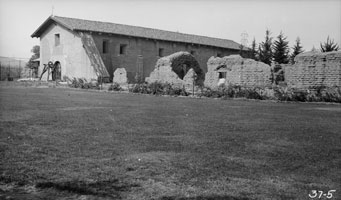








The Mission was laid out in the normal quadrangle configuration. A small chapel was completed by November 1797 and a larger one built in 1799. The main church was finished in 1806. There were four bells in the bell tower, one of which was cast, or made, in Alaska in 1796 and traded for food by a Russian count. Southern California was hit by a series of large earthquakes in 1812 and the Mission was damaged. The area around the Mission has suffered several earthquakes and the Mission had be to be rebuilt four times in the over century and a half between the 1812 earthquake and the very strong ‘Sylmar’ earthquake in 1971. The mission was rebuilt but was also damaged by the ‘Northridge’ earthquake in 1996.

Those that lived at the Mission went by a strict schedule. The Fathers were used to this type of lifestyle, but the neophytes were not. The structure of Mission life was one of the reasons many Native Californians tried to leave. A French explorer, Jean François de La Pérouse, visited Mission San Carlos is 1786 and wrote a detailed account of what he observed. Events at the Mission were signaled by the ringing of the Mission bells. Each day started around sunrise (about 6am). The Mission bells would ring to wake everyone and summon them to Mass and morning prayers. Prayer lasted for about an hour and then everyone would go to breakfast. Atole, a type of soup made from barley and other grains, would be served. Breakfast took about 45 minutes and then it was time for everyone to go to work.
The Fathers were responsible for running the Mission and instructing the new converts and children in the Catholic faith. Most of the men went to the fields to tend to the crops or to help with the animals while women stayed at the Mission and worked on domestic chores such as weaving cloth and making clothes, boiling down fat to make soap and candles, and tending to the vegetable gardens. Children often helped at these chores around the Mission once their religious instruction was over. Depending on the particular industry at the Mission there also might be neophytes leatherworking, metalworking, wine making, and pressing olives for olive oil.
At noon the bells would ring again for everyone to gather for dinner, what we would call lunch. Lunch was normally pozole, another thick soup with beans and peas. After an afternoon break everyone returned to their work for another two to four hours depending on how much work there was to be done. A last bell would be rung to end the work day. Another serving of Atole would be served and the neophytes would be able to rest until it was time for bed (Margolin, Pg. 85). Women were usually expected to go to bed by 8pm and men by 9pm. Most of the Fathers allowed their neophytes to continue to hunt and gather additional foods and to cook some of their traditional dishes.
Living at the Mission was often difficult for new converts. They were used to working when work needed to be done and resting when they were tired. The Mission lifestyle was different. The Neophytes were the main source of labor for the Missions. It was their hard work along with the soldiers’ and Fathers’ that built the Missions and their outbuildings. Agriculture and ranching required constant tending to the crops and animals. Without this labor the Missions would not have been able to survive. Many neophytes missed the freedom of their tribal life and would try to leave the Mission. The Fathers wouldn’t allow neophytes to leave and would send soldiers to search for them and bring them back. Runaways were usually punished for breaking the rules.
The Mission produced wine from its grapevines and olive oil from its olive trees. Mission workers were very well known for their ability to work with leather and to use iron to create tools and ornaments for the Mission.

 The Mission was secularized in 1834. and by 1845 Governor Pio Pico had leased the Mission lands to his brother. Eventually another owner was found and Pio Pico’s brother Andres was able to keep half of the land. By 1888 the Mission was being used as a hog farm and warehouse. The fall of the Mission was publicized by the Landmarks Club in 1896 and attempts were made to save it.
The Mission was secularized in 1834. and by 1845 Governor Pio Pico had leased the Mission lands to his brother. Eventually another owner was found and Pio Pico’s brother Andres was able to keep half of the land. By 1888 the Mission was being used as a hog farm and warehouse. The fall of the Mission was publicized by the Landmarks Club in 1896 and attempts were made to save it.

- The Author’s Name: Tricia Weber
- The Title of the Page: (Look at the banner at the top of the page.)
- The Date the Page was Last Updated: August 18, 2006
- The URL(Web Address) of the Page: (Look in the Address Bar at the top of the page.)
- The Date you Visited the Page: Use today’s date.